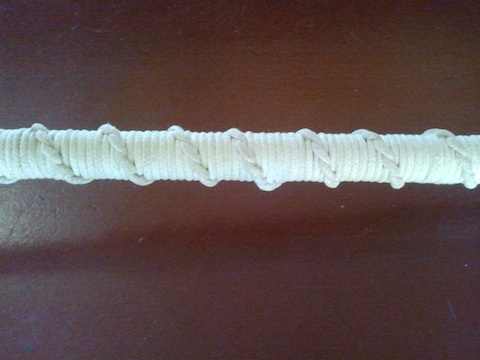
Tommy Ursetti from Sarasota County (FL) Station 5 sent in this photo of a different method of creating a tool wrap. This wrap simply uses cotton clothes line rope and some half hitches. The wrap is technically called a Chinese staircase, named from the spiral that is formed as the knot is tied. The wrap is started with a clove hitch at one end followed by multiple half hitches pulled tight after each knot. The wrap is finished with a another clove hitch and secured with super glue. One benefit of using this style of wrap is that it tends to be a bit more durable than wraps created with tape. Any small diameter rope works well for this wrap. One potential benefit to consider when using cotton rope is that it actually gets a little tighter when wet. Para-cord (550 cord) also works very well. It tends to create a flatter wrap if the inside stands of the cord are removed prior to wrapping the tool. Its a big pain to remove the strands, but some people prefer the flatter wrap. Tommy mentioned that he actually learned this wrap from Chris Kelly and Lt. Jerry Jensen.
Some people prefer modifying their tools with grips, others do not. There are obvious pros and cons. Whatever your preference is the key to success is to take care of your tools, and train with them regularly.

This seems like the perfect place for a tool-wrapping joke, but I think we’re all above that……or are we?
Don’t be a fool wrap your tool! We’re not above anything DMAN.
I can say from experience, I much prefer a tool with a wrapped handle over one that isn’t. The tool (and the user) can still get the job done, but why not make our job a little bit easier?
Come on Dman, get a grip on yerself!
As if!
Tommy, atta boy for sharing. And CK & Big Daddy, I’ll send up Truck 84’s tools for RE-WRAPS lol. I like that much better then the O2 tubing and hockey stick tape we use on all of our stuff. Good Stuff!!! Be safe brothers!!!
The hitch illustrated is the “French Sennet Wrap” The “How to” using wire and Hockey tape is well documented in my book and videos “Tools of the Trade, Firefighting Handtools and their use” pubished by Pennwell pubishing.
–Rick Fritz
Glad to see my former SCFD brothers contributing, I hope all is well. Big Daddy still passing the craft I see. Things are great in Pierce Co, WA.
The use of the tool wrap has become more and more prevalent in the fire service as late admirably pushed forward by company pride and wanting to better ourselves as firemen.
I however think it is important to note with every example of the tool wrap that the wrapping of the Halligan should be avoided at all costs. Wrapping the Halligan prevents the easy slide of a flat head axe down it’s shaft into the taper at the start of the fork. In fact in my experience it becomes impossible to utilize this method.
Please keep this in mind and discourage wrapping Halligans.
Foodforthought,
In reality, how many times is that even necessary? I’m not trying to argue with you, I’m just saying that it doesn’t seem like that’s a big enough issue.
Foodforthought,
While it’s not a big enough issue for my dept., I would offer a suggestion for a happy medium. If you find that you use the shaft method (insert joke here), but still want the grip, why not stop the wrap 12″ above the forks? You’d still get the benefit of improved grip, along with plenty of space to slide the axe.
Wrapping a grip to improve your Halligan should not interfere with its use. If it does, you may be wrapping it wrong. wrapping a Halligan does require frequent wrap changes. The “How to†using wire and Hockey tape is well documented in my book and videos “Tools of the Trade, Firefighting Handtools and their use†published by Pennwell publishing.I agree that it doesn’t seem like that’s a big issue.
–Rick Fritz
Anyone try skate board decking…. I did the decking to my roof hook and no matter how wet or dirty still has plenty of grip.. I used super glue to keep the edges down and have no problems